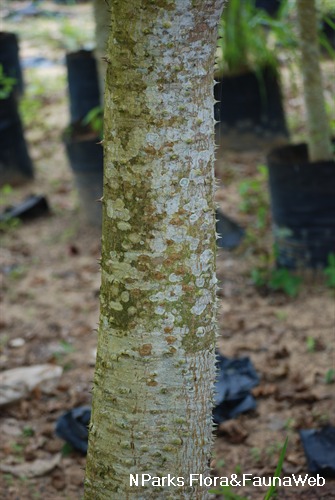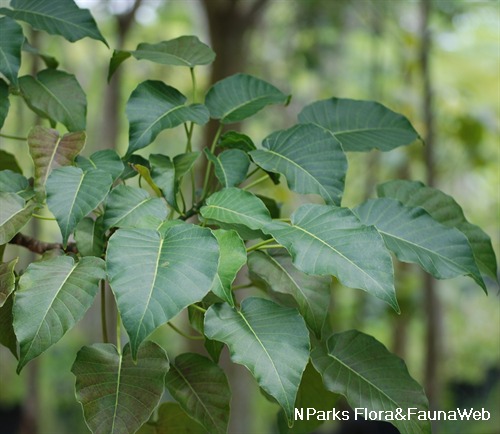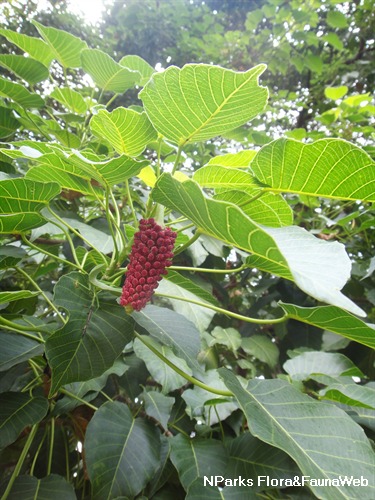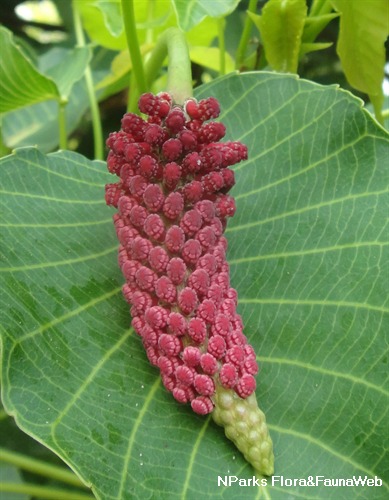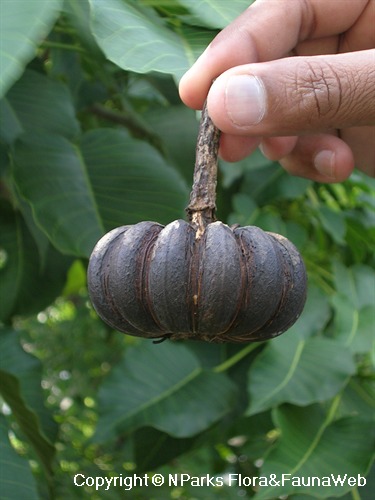
Back
Hura crepitans
| Family Name: | Euphorbiaceae |
| Common Name: | Sandbox Tree, Monkey's Dinner Bell, Huru, Pin Wheel Tree |
Name
Classifications and Characteristics
| Plant Growth Form | Tree |
|---|---|
| Mode of Nutrition | Autotrophic |
Biogeography
| Native Distribution | Tropical North and South America |
|---|---|
| Native Habitat | Terrestrial |
| Preferred Climate Zone | Tropical |
| Local Conservation Status | Non-native |
Description and Ethnobotany
| Growth Form | Large tree, able to grow up to about 40 m tall in its natural habitat. |
|---|---|
| Trunk | Surface of trunk has dark, conical spines, bark is grey. |
| Foliage | Green broadly ovate leaves, texture papery thin, measuring about 5 - 29 cm long and 5 - 17 cm wide, petiole about 5 - 20 cm long, margins slightly dentate. |
| Flowers | Monoecious, male red flowers with no petals borne on a spike inflorescence about 5 cm long, female reddish brown flowers are solitary and in leaf axils. |
| Fruit | Fruit is a dehiscent pumpkin-shaped capsule about 3 - 5 cm long and 5 - 8 cm wide, turns to reddish-brown when ripen, contains flattened seeds about 2 cm wide. |
| Others - Plant Morphology | White sap exudes from the plant when injured. |
| Etymology | Genus Hura is from a vernacular South American name. Species crepitans means rattling and refers to the seeds in the fruit capsule. |
Landscaping Features
| Desirable Plant Features | Ornamental Flowers |
|---|---|
| Landscape Uses | Suitable for Roadsides, Parks & Gardens |
| Usage Hazard - Cons | Toxic Upon Ingestion, Irritant - Sap |
Plant Care and Propagation
| Light Preference | Full Sun |
|---|---|
| Water Preference | Moderate Water |
| Plant Growth Rate | Moderate |
| Rootzone Tolerance | Moist Soils, Well-Drained Soils |
Foliar
| Mature Foliage Colour(s) | Green |
|---|---|
| Foliar Attachment to Stem | Petiolate |
| Foliar Apex - Tip | Acuminate, Caudate |
| Foliar Base | Cordate |
Floral (Angiosperm)
| Flower Colour(s) | Red |
|---|
Image Repository
Others
| Master ID | 1673 |
|---|---|
| Species ID | 2966 |
| Flora Disclaimer | The information in this website has been compiled from reliable sources, such as reference works on medicinal plants. It is not a substitute for medical advice or treatment and NParks does not purport to provide any medical advice. Readers should always consult his/her physician before using or consuming a plant for medicinal purposes. |

